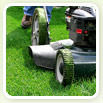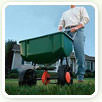Sod Care and Maintenance
The following are a few tips which are extremely important when grass is installed during late spring and summer:

WATERING
Watering is best accomplished by using an oscillating type sprinkler and keeping the new turf moist for the first 4 weeks. Watering can gradually be tapered down, but will still be required during hot, dry periods during the first summer. The best time to water is early morning or in the evening. Try to avoid watering in the middle of the day during hot temperatures.
Corners and edges of newly sodded areas tend to dry out sooner and can be difficult to water properly. It may be necessary to water these areas by hand. If a newly sodded area does dry out and appear yellow or brownish. It is most likely not dead, and will usually green up in about two weeks with proper water application.
It usually takes about a few weeks for the sod to fully take root. At this point watering can be lessened to approximately twice per week depending on the weather conditions. Frequent shallow water applications are not good for an established lawn. This causes the root system to grow near the surface versus driving deep healthy roots. It is much better to water less often but more thoroughly.

MOWING
New sod should be allowed to root enough that it cannot be easily pulled up before the first mowing. Prior to mowing, cut back on the watering to ensure the ground is firm enough to support the weight of the mower without leaving ruts. Never remove more than 1/3 of the grass blade during any one mowing.
It is very important that Kentucky bluegrass and turf type fescue be maintained at a height of 3 inches or above during the first summer. Lawns should not be mowed when temperatures are above eighty-five degrees. During extremely hot periods lawns should be mowed in the evenings when temperatures are not so high and the grass plants can recover over night.
If the lawn is very dry, watering should be done prior to mowing. If for some reason your lawn is allowed to get very tall, (above 6 inches) it should be taken down gradually.
Remember: Improper mowing practices can cause an established lawn to go into shock. It is all the more important that a new lawn, which is already under the stress of being transplanted, be mowed correctly.

FERTILIZING
All sod that we put down will have been fertilized at the time the turf was installed. This will last approximately five to six weeks. At this point the homeowner should refertilize, preferably a slow release fertilizer, at the manufacturers recommended rate.